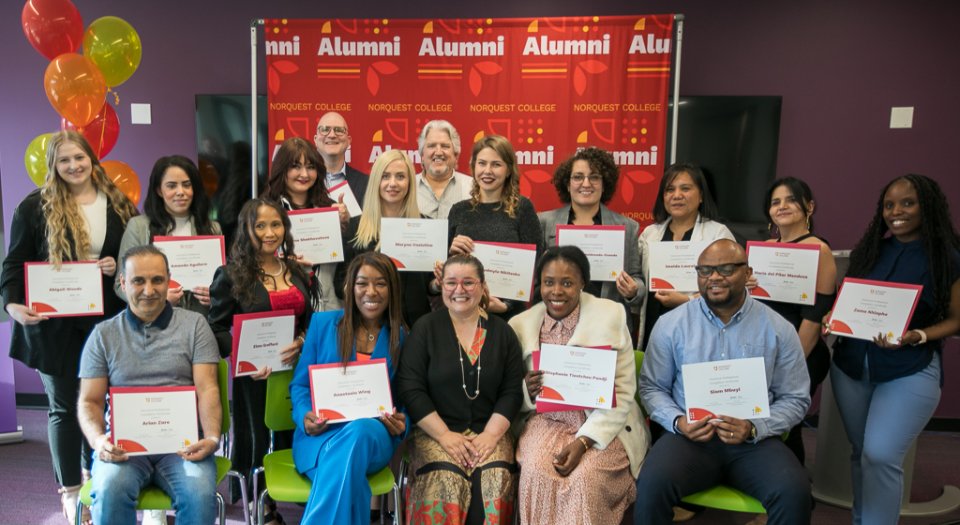A first-hand NorQuest perspective of belonging
June 20, 2019

Left picture: Flora Rivard (Ginther) Conor's great grandmother, Patsy Kerr (Ginther) Conor's grandmother, and Genevieve Rivard (Gladue) Conor's great-great grandmother, and Conor's father, Jim Kerr in the front. Right picture: Conor and his grandmother, Patsy Kerr (Ginther).
This is his story:
On July 30th, 1886 my great-great-great grandfather Charles Batteau Gladue was discharged from Treaty 6. Ten years earlier he had been a witness to his father, John Gladieu Quinn, as he signed that same Treaty on behalf of the Papaschase Nehiyawak. As a result of them being discharged from Treaty 6, they were no longer allowed to live on the land that they had been on for untold generations.
They were no longer allowed to raise their children on the soil that held the blood, bones, stories, soul, and teachings of their families. They were no longer allowed to freely intermingle with their relations and friends in the neighboring communities of Maskwacis, Maskekosihk, and Lac Ste. Anne. Their story in Edmonton was supposed to be erased, gone, effectively colonized and removed. No-one would hear their names, and the newcomers to Amiskwaciy Waskahegan would never know that the soil that they built their houses, skyscrapers, schools, roads, and communities on held powerful stories.
One hundred and ten years later, in 1996, National Aboriginal Day was proclaimed by the former Governor General Romeo A. LeBlanc. It would be an annual celebration held on June 21 to recognize and celebrate the cultures and contributions of First Nation, Inuit, and Metis Indigenous Peoples of Canada. My great-grandmother passed away that same year and I remember driving up with my grandmother from Buffalo Pound Lake, Saskatchewan for the funeral in Edmonton.
I had never been to Edmonton before. My experience was in the small towns of Saskatchewan and as a seven year old I was mesmerized by how big the skyscrapers were and the expanse of people that went on and on for as far as I could imagine. My grandmother, on the other hand, had lived a whole life in this city—one where she hid her knowledge of the land around her and the language that she spoke in the confidence of her sisters and aunties, behind her white-facing presence. Some of her sisters didn’t have that same melatonin privilege.
$$$block1$$$Our first day in the city my grandmother packed a thermos of tea and a couple bologna and mustard sandwiches into a ratty old green army issue backpack and took me down to the south side of the North Saskatchewan River, around where the old Walterdale Bridge crossed from the Kinsmen. We walked downstream along an unused, overgrown trail for what I figured was forever until we came across a little clearing. My grandmother told me that it was right around this spot that her granny (my great-great grandmother, daughter of Charles Batteau Gladue) was born.
As a child my grandmother lived with granny in the bush north of St. Paul, Alberta. That was where granny and her family ended up after being forced out of their traditional lands. My grandmother told me about sitting up late into the night, drinking Labrador tea, and placing the beads onto granny’s needle for her as her arthritic hands shook. Granny would tell her stories about her family and their culture. She told her to be proud of who she was. My grandmother carried that to heart and I feel very fortunate that she passed that same pride onto me that day on the trail. As we sat on the grass in that clearing, shaded from the skyscrapers on the north side of the river, and drank our tea and ate our sandwiches, I knew that I belonged to something.
As we sat on the grass in that clearing, shaded from the skyscrapers on the north side of the river, and drank our tea and ate our sandwiches, I knew that I belonged to something.
On June 21st, celebrations of Indigenous culture will be happening across Amiskwaciy Waskahegan and area. While those celebrations and events on the surface may be entertaining, and as you attend them I encourage you to look deeper into the meaning behind them and start asking critical questions of how you are bringing reconciliation into your personal life and your professional practice; or if you self-identify as Indigenous, how are you ensuring that future generations will be able to build their own story framed within the teachings of their Elders, knowledge keepers, family and community.
This isn’t something that should only happen once a year. Every breath that an Indigenous person takes, every footstep that they walk, every new child that is born is an act of resistance against colonialism, and we need to acknowledge that daily, not just once a year.
The resiliency of the matriarchs in my family to persevere against all odds, in a society that actively tries to disempower them on a regular basis continues to astound me. Because of their continual struggle to pass their cultural knowledge and story on to future generations I’m able to sit here and write this. Everything I am, I owe to them. So this year on June 21st, and every other day of the year, I’m going to be celebrating and honoring them.


